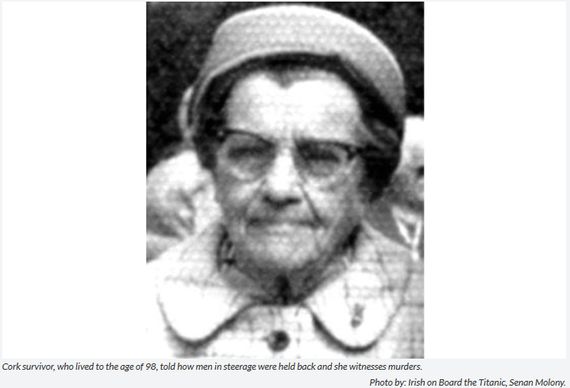
News 17. 4. 2016
Titanic sank 104 years ago today and 129 Irish lost their lives
April 2, 1912, 6:00 – Titanic began sea trials
It’s estimated that over 100,000 people turned out to watch the launch of the Titanic from the Queen’s Island slipway. This was a golden age of shipbuilding in Belfast and the city showed its pride.
April 3, 1912 – Titanic arrived in Southampton

April 10, 1912
9:30 -11:30am – Passengers arrived in Southampton and began boarding the ship
12pm – The Titanic set sail and began her maiden voyage
Even before they had left port, at Southhampton, the Titanic passengers and crew had a scare as they almost collided with another large liner, the New York.
6:30pm – Titanic reached Cherbourg, France and picked up more passengers
April 11, 1912, 11.30am – Titanic reached Queenstown (now Cobh), in County Cork
The local newspaper, the Cork Examiner, printed an account of the historical arrival of the Titanic at Cork Harbour.
It read:
„As one saw her steaming slowly, a majestic monster floating it seemed irresistibly into the harbor, a strange sense of might and power pervaded the scene. She embodies the latest triumphs in mercantile engineering.“
Seven people disembarked, including the famous photographer Father Francis Brown. One hundred and three people boarded the ill-fated ship at Queenstown.
April 12 & 13, 1912 – The Titanic sailed through calm waters
April 14, 1912
Throughout the day seven iceberg warnings were received, some even made it to the bridge. The Titanic, traveling at 22.5 knots, was heading straight for the ice field.
11:40pm – Lookout Frederick Fleet spotted an iceberg dead ahead. The iceberg struck the Titanic on the starboard (right) side of her bow

11:50pm – Water had poured in and risen 14 feet in the front part of the ship
Having failed to alter its course the Titanic struck the iceberg and ruptured at least five of its hull compartments. The compartments filled with water and pulled down the bow of the ship. The compartments, built to save the ship from sinking, were not capped at the tops. Water from the ruptured compartments filled each succeeding compartment, causing the bow to sink and the stern to be raised up to an almost vertical position above the water.
April 15, 1912
12:00am – The captain was told the ship could only stay afloat for a couple of hours. He gave the order to call for help over the radio.
12:05am – The orders were given to uncover the lifeboats and to get passengers and crew ready on deck. There was only room in the lifeboats for half of the estimated 2,227 on board.
12:25am – Loading of the lifeboats began with women and children first.
The Carpathia, which was approximately 58 miles southeast of the Titanic, picked up the distress call and changed course to aid the stricken liner and her passengers.
12:45am – The first lifeboat was safely lowered away. Although it could carry 65 people, it left with only 28 on board.
The first distress rocket was fired. Eight rockets were fired the whole night.
2:05am – The last lifeboat left the ship.
There were still more than 1,500 people left on the ship. The tilt of Titanic’s deck grew steeper and steeper.
2.17am – The last radio message was sent.
The captain announced “Every man for himself.”

2:20am – The Titanic’s broken off stern settled back into the water, becoming more level for a few moments. Slowly it filled with water and tilted its end high into the air before sinking into the sea. People in the water slowly froze to death.
3.30am – Carpathia’s rockets were spotted by the survivors.
4:10am – The first lifeboat was picked up by the Carpathia.
8:50am – The Carpathia left the area bound for New York. She had 705 survivors of the Titanic disaster on board.
April 18, 1912, 9:00pm – The Carpathia arrived in New York.
An hour and 20 minutes after the Titanic went down the Cunard Liner, Carpathia arrived. It was later discovered that the Leyland Liner, the Californian, was only 20 miles away but had failed to hear the Titanic’s distress signals as the radio operator was off duty.

Due to human errors, the shortage of lifeboats and lack of satisfactory emergency procedures the Titanic went down and took 1,500 souls with it. Most of the 700 survivors were women and children. Among those who died were notable names such as the noted British journalist William Thomas Stead and heirs to the Straus, Astor, and Guggenheim fortunes.
There were many Irish among the survivors and 129 among the dead.
April 19 to May 25 – American inquiry into the disaster was held
April 22 to May 22 – Several ships were sent to the disaster site to recover bodies. A total of 328 bodies were found floating in the area.
May 2 to July 3 – British Board of Trade inquiry into the disaster was held
News of the tragedy caused outrage, on both sides of the Atlantic. The disaster led to the first International Convention for Safety of Life at Sea, which was held in 1913. Rules were adopted to ensure there was a safe ratio of lifeboats to people on ships and that safety drills be held. The International Ice Patrol was also established to monitor icebergs in the North Atlantic shipping lanes. It is also required that ships have a 24-hour radio watch.
September 1, 1985 – A Franco-American expedition located the wreck of the Titanic lying on the ocean floor at a depth of c.13,000 feet.
Kate Hickey @KateHickey_
Václav Bernard



